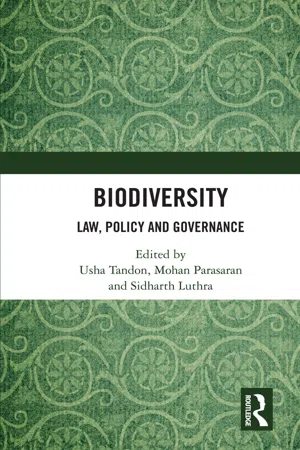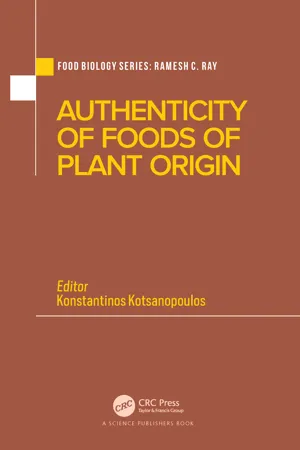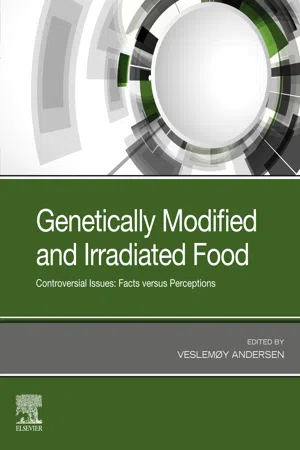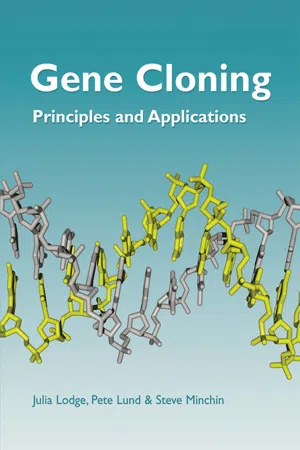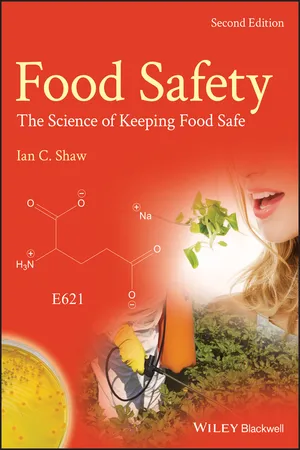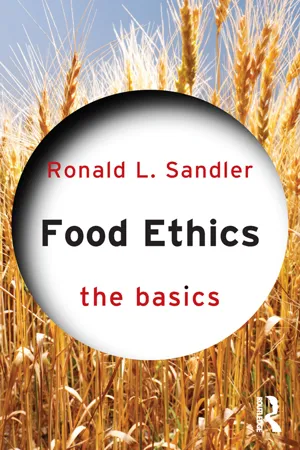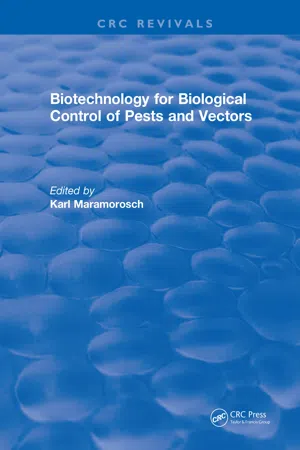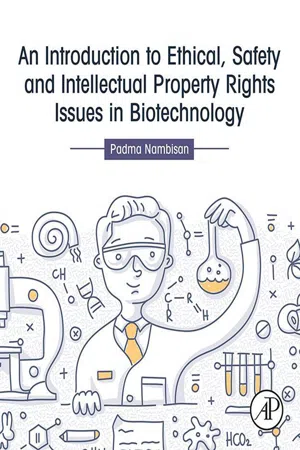Biological Sciences
Genetically Modified Organisms
Genetically Modified Organisms (GMOs) are living organisms whose genetic material has been altered using genetic engineering techniques. This can involve the introduction of new traits or the modification of existing ones. GMOs are commonly used in agriculture to improve crop yield, resistance to pests, and tolerance to environmental conditions. The use of GMOs is a topic of debate due to concerns about potential environmental and health impacts.
Written by Perlego with AI-assistance
Related key terms
Related key terms
1 of 4
Related key terms
1 of 3
12 Key excerpts on "Genetically Modified Organisms"
- eBook - ePub
Genetic Engineering
Volume 2: Applications, Bioethics, and Biosafety
- Tariq Ahmad Bhat, Jameel M. Al-Khayri, Tariq Ahmad Bhat, Jameel M. Al-Khayri(Authors)
- 2023(Publication Date)
- Apple Academic Press(Publisher)
GMOs are those which have foreign genes. Genes with desired characteristics are identified and isolated. Then these isolated genes are introduced into target organisms with the help of biological vectors. These transgenic organisms having genes of interest from other organisms incorporated into their genome are called GMOs. GMOs are essentially to be analyzed properly prior to use. The key features in context of use of GMOs may exhibit side-effects for health. The use positive use of GMOs is also beneficial to cope the needs of everlasting increment in the human world population. The GMOs are providing very promising scope in human history._____________________ Genetic Engineering, Volume 2: Applications, Bioethics, and Biosafety. Tariq Ahmad Bhat & Jameel M. Al-Khayri (Eds.) © 2023 Apple Academic Press, Inc. Co-published with CRC Press (Taylor & Francis)5.1 Introduction
With advancement in biotechnological protocols, scientists are able to detect particular genes controlling a specific characteristic. Isolation of genes of interest is also possible and at the same time transfer of genes of interest to new organisms is now possible. The organisms which contain genes of interest isolated from other organisms are termed as Genetically Modified Organisms (GMOs) (James, 2016 ). Biotechnology has unable scientists to alter the genetic makeup of organisms and to make them an ideal organisms with desired characteristics. Such GMOs are widely being prepared to meet human needs (Hill, 2005 ).GMOs are not only good yielding and less laborious to handle but they come up with the ability to control the pollution, pests, and abiotic stresses of heavy metals. GMOs may be used to produce specific proteins or growth promoters for other specified organisms, including human beings. Some of the genetically modified microorganism have the ability of reclamation of acidic soils (Sehubent, 2002). The introduction of GMOs still needs careful observations as they are able to disturb the ecological cycles or lifecycles of other species found nearby (Tzotzos et al., 2010 - eBook - ePub
Biodiversity
Law, Policy and Governance
- Usha Tandon, Mohan Parasaran, Sidharth Luthra(Authors)
- 2017(Publication Date)
- Routledge India(Publisher)
Part IVGenetic engineering
Problems and prospects
Passage contains an image
7 Genetically modified crops
Neither poison nor panacea
Parikshet SirohiGenetically Modified Organisms (GMOs) can be defined as organisms, whether plants, animals or microorganisms, in which the basic genetic material (DNA) has been altered in a manner that does not occur naturally by mating and/or natural recombination. This technology is often called ‘modern biotechnology’1 or ‘gene technology’,2 and is sometimes also referred to as ‘recombinant DNA technology’3 or ‘genetic engineering’.4 It allows selected individual genes to be transferred from one organism to another, and also allows such transfer amongst organisms belonging to non-related species. Foods produced from or using GMOs are often referred to as Genetically Modified (GM) foods.5 The resulting plant is said to be ‘genetically modified’ although in reality, all crops have been genetically modified from their original wild state by domestication, selection and controlled breeding over long periods of time.6Doing something that does not occur in nature, unsurprisingly, makes some people nervous. Globally, a record 17.3 million farmers grew GM crops in the year 2012, up from 16.7 million farmers in 2011. Worldwide, 170.3 million hectares were planted with GM crops in 28 countries, which is a hundred-fold increase since the time they were first introduced in the year 1996. The area under GM crop cultivation today is about the same size as the territories of Spain, Germany, France and the UK combined.7Traditionally, farmers and plant breeders have attempted to produce plants with desired traits by undertaking the process of exchange of genes between two species of plants. This is done by transferring the male (pollen) of one plant to the female organ of another. This cross-breeding, however, is limited to exchanges between the same or very closely related species. It may also take an extremely long period of time to achieve the desired results and frequently, characteristics of interest do not exist in any related species.8 GM technology has enabled plant breeders to bring together, in one plant, useful genes from a wide range of living sources, not just from within the crop species or from closely related plants, but from other organisms as well. This powerful tool allows plant breeders to do, in a faster and more effective manner, something that they have been doing for years, namely generation of superior plant varieties.9 The additional advantage of this technology is that it significantly expands these possibilities as it enables scientists and breeders to go beyond the limits imposed by conventional plant breeding.10 - eBook - ePub
- Konstantinos Kotsanopoulos(Author)
- 2022(Publication Date)
- CRC Press(Publisher)
6 Detection of Genetically Modified Organisms in Foods of Plant OriginSpiros Paramithiotis,* Maria K Syrokou and Eleftherios H DrosinosLaboratory of Food Quality Control and Hygiene, Department of Food Science and Human Nutrition, Agricultural University of Athens, Greece.* Corresponding author: [email protected]1. Introduction
The definition of genetically modified organism (GMO) is clearly stated in article 2(2) of the directive 2001/18/EC of the European Parliament and of the Council: ‘an organism, with the exception of human beings, in which the genetic material has been altered in a way that does not occur naturally by mating and/or natural recombination’. In order to remove any doubt that may occur, the techniques that lead to genetic modification are listed in Annex 1 A, part 1, while the ones that are not considered to result in genetic modification are listed in Annex 1 A, part 2 of the same directive.There are currently two generations of genetically modified crops that have been developed and made commercially available. The first generation aims to assist the farmer during production; crops have been modified to offer resistance to insects, or other adverse environmental conditions and facilitate the application of certain herbicides. The second generation aims to provide benefits to the consumer, mainly through an enhanced nutritional content.The worldwide acreage covered by genetically modified crops, from 1996 to 2017, is presented in Fig. 1. This period may be further subdivided into three terms. The first one, from 1996 to 1999, is characterized by a rapid increase of the total cultivation area every year, from the 1.7 million hectares of 1996 to the 39.9 million hectares of 1999. The second term is from 2000 to 2010, during which an annual increase of more than 10% on average was noted. The total area in 2000 was 44.2 million hectares and reached 148 million hectares in 2010. Finally, a third period, from 2011 to 2017, is observed. During the latter, an annual increase of less than 5% on average was noted. The USA is the top cultivation country, in which 40% of the worldwide cultivation area is located. Brazil is in second place with 26% followed by Argentina (12%), Canada (7%) and India (6%). Soybeans are the top cultivated crop, accounting for 49.6% of the cultivated genetically modified crops, worldwide. Maize is in second place with 31.8%, followed by cotton (13.1%) and canola (4.9%) (ISAAA 2017 - eBook - ePub
Genetically Modified and Irradiated Food
Controversial Issues: Facts versus Perceptions
- Veslemøy Andersen(Author)
- 2020(Publication Date)
- Academic Press(Publisher)
Genetic modification is a term that captures the imagination of many people and has generated wide debate among many groups of interest, including life scientists, policy makers, and law and ethical specialists, while citizens from developed, developing, and underdeveloped countries are facing this issue from different perspective. The ongoing basic research aims to understand the genetic modification -specific cause-effect type of correlations and make use of the GMOs to study the function of genes. On the other hand, the heavily questioned applied research is meant to offer novel and efficient solutions for current problems like biomass production, food safety and security, treatment of human diseases, adaptation of plant and animal species to climatic changes, etc.Can we stay impartial and face the reality with respect to genetic modifications? In order to address in a fairly comprehensive way the main issues related to GM food, we will present the major issues related to the natural occurrence and laboratory-made GM bacteria, plants, and animals. Next we will focus on GM food–specific major considerations and concerns. In this way, we will follow the implications of genetic modification across the whole food chain giving a much broader and a more carefully balanced picture of the applicability of such a powerful and promising life science–related research method.The definition of genetic modification refers to a naturally and/or laboratory-assisted genetic material–/gene-/DNA-based phenomenon that would lead to some kind of modification(s) of the genome/DNA of the host organism, hence the term of genetically modified (recombinant) organism (GMO) emerges. It is also important to notice that initially the genetic modification term would cover both the naturally and laboratory condition–assisted genetic modifications, while currently it is more related to the laboratory-obtained transgenic organisms, containing a foreign piece of DNA (gene(s)) from other species. - eBook - ePub
- Julia Lodge, Peter Lund, Steve Minchin(Authors)
- 2007(Publication Date)
- Taylor & Francis(Publisher)
12 The Production and Uses of Transgenic Organisms
Learning outcomes:By the end of this chapter you will have an understanding of:- what is meant by the expression “transgenic organism”
- why such organisms are powerful tools in biological research
- some of the applications of transgenic organisms
- some of the different methods used for constructing transgenic organisms
- the production and uses of knockout organisms
12.1 What is a Transgenic Organism?
A transgenic organism is one which contains novel heritable genetic material, derived from a different species using molecular cloning techniques. Although the name “transgenic” can be applied to any organism which fits the definition, it is unusual for bacteria or single-celled eukaryotes which have been genetically modified to be referred to as being transgenic. Instead, the expression is mostly used to refer to multicellular eukaryotes. This is the only sense in which the term will be used in this chapter. Often, the term “genetically modified organism” (or “GMO”) is used to refer to transgenic organisms. There is no difference in meaning between these two expressions.The novel DNA which is introduced into cells can take many forms. In the case where it consists of one or more genes which encode novel proteins, these are often referred to as transgenes. To be expressed, the novel gene will need to be under the control of a promoter. This will determine the level to which it is expressed, and can also determine when during development and where in the organism it is expressed. For an organism to be truly transgenic, it has to contain a transgene in all of its cells (Figure 12.1 ). This means that the gene must be stably replicated along with the host DNA in every cell cycle for all cells (Figure 12.2 - eBook - ePub
Food Safety
The Science of Keeping Food Safe
- Ian C. Shaw(Author)
- 2018(Publication Date)
- Wiley-Blackwell(Publisher)
Transgenic farm animals might also be used to manufacture pharmaceuticals. For example, cows expressing the gene for human insulin excrete insulin in their milk; so it is conceivable that one day farming might become ‘pharming’ and ‘pharmers’ will milk their GM human insulin cows and sell the milk to the pharmaceuticals industry where the insulin will be extracted for the treatment of human diabetes. This is far beyond the scope of this book but is an interesting thought that is fast gaining credibility – in just a few years it is likely to be reality.Take home messages
- Genetic modification involves adding a gene to a crop or animal that confers some positive characteristics (e.g. resistance to herbicides).
- Genetic modification is controversial and there is still significant debate about whether it is acceptable on both safety and environmental grounds.
- Some countries freely allow GM crops providing strict regulations are followed (e.g. the USA). Other countries do not allow GM crops or their products (e.g. New Zealand).
- The commonest GM crops are glyphosate (a herbicide) resistant and BT toxin (an insecticide) expressing.
- GM crops could be used to solve global nutritional problems (e.g. Golden Rice – vitamin A deficiency).
Further reading
- Garrett RH & Grisham CM (2010) Biochemistry, 4th edn. Chapter 10, Nucleotides and Nucleic Acids. Brooks/Cole, Boston. This is an excellent in‐depth account of the chemistry and function of nucleic acids; it provides all of the background you will need to understand the cell biology and biochemistry behind genetic modification.
- Kammermeyer K & Clark VL (1989) Genetic Engineering Fundamentals. Chapter 7, Recombinant Techniques. Marcel Dekker, New York. This gives a good account of the methods used.
- Parekh SR (ed.) (2004) The GMO Handbook. Humana Press, Totowa.
- Ruse M & Castle D (eds) (2002) Genetically Modified Foods
- eBook - ePub
- Ronald L. Sandler(Author)
- 2014(Publication Date)
- Routledge(Publisher)
as such . Many people believe that intentionally creating transgenic or interspecific individuals is wrong, independent of the consequences or outcomes of doing so. As discussed earlier, intentional genetic hybridization across species is common and unobjectionable when done by traditional breeding techniques. Moreover, if engineering organisms were itself objectionable, virtually all of our food supply and all of our companion animals (and house plants) would be ethically problematic. The concern with bioengineering GM crops (and animals) is that it involves mixing genomic material of species to create novel life-forms that could not have existed in the absence of human agency. It is, therefore, charged with being unnatural, hubristic, and playing God. In this section, I discuss these three prominent intrinsic objections to GM crops.The term “natural” is ambiguous. It is sometimes used to refer to everything in the physical world—that is, everything that acts according to the laws of nature. Other times, it refers only to the biological or ecological world. Still other times, it is used to refer to everything in the world that is neither human nor the product of human agency. Therefore, whether GM crops are unnatural depends upon which meaning of the term is operative. They are part of the physical world, and in that sense natural. They are a modified part of the biological world, so in that sense partially natural. They are created and used by humans, so in that sense unnatural.However, the fact that GM crops are unnatural in the sense of being the product of human agency does not make them unethical. If it did, then cars, phones, yogurt and Chihuahuas would all be ethically objectionable. All engineering and technology involves modifying things or creating things not found in nature. Moreover, we are technological animals. Intentionally modifying the world is crucial to our form of life. We cannot equate something’s being the product of human agency with its being unethical.The foregoing is an argument from cases, and it is a reductio ad absurdum . That is, it aims to show that if you accept the principle “if something is the product of human agency and could not have otherwise existed, then it is objectionable,” the implications are absurd, since it would evaluate things that are clearly not ethically problematic as ethically problematic. However, there is also a deeper conceptual problem with the evaluative use of “natural”: nature is not normative for us. We have already seen that the fact that something is not found in nature or does not occur in nature does not make it wrong for us to do or create. In addition to this, the fact that something is found or occurs in nature does not make it permissible for us to do. The biological world is characterized by predation; deception is commonplace; forced copulation occurs in many species; and parents only very rarely raise or protect their offspring. Thus, whether or not something occurs in nature is not normative or prescriptive for us. To take nature as normative commits the fallacy of appeal to nature - eBook - ePub
- (Author)
- 2014(Publication Date)
- Meanjin Digital(Publisher)
No assessment of risk can be made without reference to a set of values or moral principles. Our modern global society places a higher value on human activity than on natural processes. This leads us to circumvent the limitations of ordinary physiological processes, like sexual reproduction, so that we can produce organisms regarded by some people as more ‘desirable’, largely for commercial reasons. No intrinsic value is assigned to the provenance of three billion years of evolution—human intervention has superseded it and humans now assume to manage its future. It is my view that the large-scale application of genetic engineering in the service of current human goals, especially the ‘modernisation’ of food industries, will turn out to be a more destructive way of exploiting the natural world than any previous technological innovation, including military applications of knowledge gained in nuclear physics.9In 2000, as part on an INRA/OECD forum in France, I wrote a review of safety issues in livestock GMO research. 10 I chose not to mention ethics, because I had nothing new to say. By that year I was talking to community groups thatwere concerned about GMOs. I frequently met people who were irreconcilably opposed to GMOs and whose intellectual world view barely overlapped with my own. It was difficult to avoid shouting matches, impossible to avoid some dialogues of the deaf.I recall particularly talking to a group of organic farmers. I began by working through a number of recent genetic technologies or outcomes that had been carried out by ‘conventional’ but modern means, such as cloning and interspecific hybrids. At the end of each example, I said, ‘But that’s not genetic engineering.’ After my final example, I added, ‘Genetic engineering is …’ then paused to draw breath and put up a slide showing a definition. I was forestalled by a ‘horny-handed son of toil’ in the front row, less than two metres away: ‘Evil!’ he bellowed at me. If I had ever had the audience on my side, I lost it then. - eBook - ePub
Food & Faith
Justice, Joy, and Daily Bread
- Michael Schut(Author)
- 2010(Publication Date)
- Morehouse Publishing(Publisher)
Genetically Modified Organisms
As we learned from experience with DDT, nuclear power, and CFCs, we only discover the costs of new technologies after they are extensively used. We should apply the Precautionary Principle with any new technology, asking whether it is needed and then demanding proof that it is not harmful. Nowhere is this more important than in biotechnology because it enables us to tamper with the very blueprint of life.—David SuzukiIt's not the nature of genetic engineering itself that's the problem; it is the way genetic engineering has evolved. Early on, it came under the control of the private sector…. By definition, the private sector's goal is to make money. It will not focus its attention on the needs of the poor, except as a way to sell its products.—Tewolde EgziabherIntroduction
Myriad questions surround genetically modified (GM) foods. Are they safe for human consumption? Will they cause ecological damage? Are they the key to “feeding the world?” What sort of policies and agricultural systems lead to food security? Who benefits—large farmers, small farmers, corporations, the hungry—when food is genetically modified? Is it ethical to take genetic material from a flounder and insert it into a tomato? Well-meaning people answer these questions differently. Let's look at two examples.First, we will consider different ideas about food security. Food security refers to a region or nation's ability to predictably maintain access to a nutritious, sufficient and safe supply of food for its population. What does food security entail, or how might food security be achieved? Here are two different perspectives:C. Ford Runge and Benjamin Senauer, Professors of Applied Economics at the University of Minnesota, answer:…it [food security] involves improving a developing nation's access to cheaper food from comparatively advantaged exporting countries. It is generally more efficient and cheaper than self-sufficiency, in which a nation tries to produce all crops that its population needs…Finally, the drive for food security should tap the potential of GM technology for developing countries to both enhance nutrition and boost agricultural output (Foreign Affairs - eBook - ePub
Organic Futures
The Case for Organic Farming
- Adrian Myers(Author)
- 2005(Publication Date)
- Green Books(Publisher)
Chapter 5 Genetically Modified Foods“So do you not feel that, buried deep within each and every one of us, there is an instinctive, heart-felt awareness that provides—if we allow it to—the most reliable guide as to whether or not our actions are really in the long-term interests of our planet and all the life it supports?This awareness,this wisdom of heart, may be no more than a faint memory of distant harmony, rustling like a breeze through the leaves, yet sufficient to remind us that the Earth is unique and that we have a duty to care for it. Wisdom, empathy and compassion have no place in the empirical world, yet traditional wisdoms would ask ‘Without them, are we truly human?’ ”—HRH Prince Charles 1Introduction‘Frankenstein food’ scare headlines in the press have detracted from the very important debate that needs to be conducted about GM foods, especially with opinions so entrenched on both sides. Because of this, and also the difficulty of separating the science from commercial interests— the general public are unsure what to think. For many people involved in organic production, however,GM crops seem irrelevant to the challenges that agriculture and society face today. There are genuine and growing concerns about the dangers of Genetically Modified Organisms (GMOs) amongst many members of the scientific community and environmentalists,concerns about the unethical and arrogant stance taken by many of the commercial companies involved in marketing GMOs. But many people involved in the organic field are beginning to feel that they are just an extension of the increasingly discredited and outdated approach to conventional farming. This approach displays more of the same limited and dangerous linear thinking but with one major difference—the results of this new technology are irreversible. Once these altered genes are out in the environment, they cannot be recalled. This is why this technology could be so dangerous. - Karl Maramorosch(Author)
- 2018(Publication Date)
- CRC Press(Publisher)
In addition to agent-specific effects, cumulative effects will result from releasing genetically engineered biocontrol agents into the environment overtime. Some scientists believe that cumulative effects may change the complexion of the environment in much more significant ways than the specific effects of any one control agent.A. Likelihood of Environmental Effects
The safety or risk of genetically engineered biological control agents cannot be stated in absolute terms. Effects will depend on many individual decisions made by researchers, biotechnology companies, and society — decisions about which host and donor organisms to use, how much and what kinds of testing to conduct prior to environmental release, and the extent and location of permissible large-scale uses.Considerable theory has developed about the safety and risks of both genetic engineering and classic biocontrol, but unfortunately, the theories in both areas are insufficiently confirmed with data and often point to conflicting conclusions. Many scientists realize that “one can use the novelty of recombinant DNA organisms to argue as effectively for their being hazardous as their being safe.”6 Similarly with biological control, some state that the record of biocontrol is without risks, while others believe just the opposite.71. Theories of Risk for Genetically Engineered Organisms
Apprehension about genetically engineered organisms originally arose because of concerns that their novelty may make them less predictable than existing organisms. During the last 20 years of experimentation with engineered organisms, a competing and more reassuring perspective has arisen, i.e., that because genetically engineered organisms often differ from their parental strains by only one or a few genes and are introduced into well-characterized, agricultural environments,8- eBook - ePub
- Padma Nambisan(Author)
- 2017(Publication Date)
- Academic Press(Publisher)
Section 4.10 ).4.8.1 Effect on Environment
The risk–cost–benefit analysis with respect to GMOs has been controversial with vastly different perceptions between the scientists, the public, and the government, on the consequences of release of GMOs into the environment. This is partly due to a lack of scientific understanding of the complexity of human and environmental systems. Making a decision to release a GMO into the environment is difficult due to the inability to predict long-term adverse effects on health and biodiversity, and unintended ecological effects .4.8.2 Effect on Biodiversity
Several NonGovernmental Organizations (NGOs), such as Greenpeace International (http://www.greenpeace.org ), and Navdhanya (http://www.navdanya.org/ ) in India, have alleged that the introduction of GMOs has resulted in a loss of local seeds and local varieties (Greenpeace, n.d. ). Many who are opposed to GM technology allege “gene pollution ” due to transfer of genes through pollen to related species and horizontal gene transfer to unrelated species.4.8.3 Effect on Sociocultural Norms
Agriculture in many communities is considered as a way of life and food has several cultural and societal norms or beliefs attached to it. New technologies that involve genetic manipulations of plants are often viewed with distrust and have stirred conflicting ideas and opinions and polarized sectors among stakeholders. At least two religious sectors, the Muslim community and the Roman Catholic Church have expressed opinions on biotechnological developments. For Muslims in Malaysia, there is a “fatwa” (religious decree) that states that GM foods with DNA from pigs are “haram ” (not permissible) for Muslims to eat (Malasian Biotechnology Information Center, 2004). In 2004, the Pontifical Council for Justice and Peace released the Compendium of the Social Doctrine of the Church which aims to present a precise but complete overview of questions concerning life in society (Vatican, 2004 ). The Compendium has three parts with twelve chapters. Chapter Ten in Part Two of the Compendium presents the opinions of the church regarding safeguarding the environment, and has a section on the use of biotechnology. In the Christian vision, nature is not a sacred or divine reality that man must leave alone , but at the same time makes a strong appeal for responsibility
Index pages curate the most relevant extracts from our library of academic textbooks. They’ve been created using an in-house natural language model (NLM), each adding context and meaning to key research topics.
Explore more topic indexes
Explore more topic indexes
1 of 6
Explore more topic indexes
1 of 4

